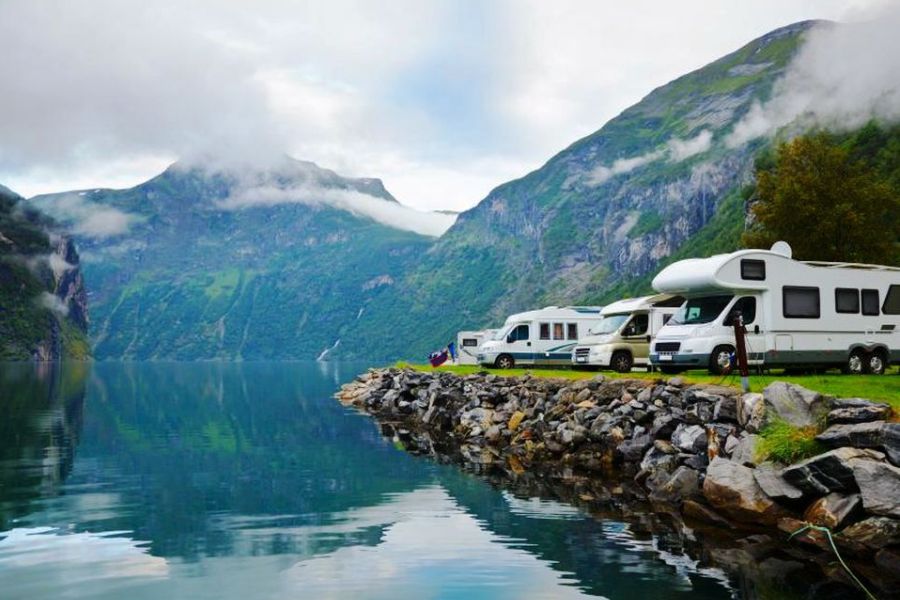In 2021, wholesale RV shipments reached a record high, topping 600,000 units. However, the landscape has changed in recent years. According to the RV Industry Association, total RV shipments in 2023 were around 291,652 units.
Despite this decline, the RV industry continues to attract a diverse range of buyers, including Millennials, who seek a mobile lifestyle that combines the comfort of home with the freedom of travel.

If you’re interested in hitting the open road with an RV, you probably need an RV loan. After all, a recreational vehicle or motorhome is as expensive as a car — and even a house. So chances are, it will be challenging to save up enough to buy an RV outright with cash.
Here’s what you need to know about how to get an RV loan.
How do RV loans work?
Most RV loans are available for between 5 and 15 years, although you might also be able to finance for 20 years, depending on how expensive the RV is. If you go to a bank or credit union and ask to borrow money for an RV, you might be subject to greater scrutiny.
The reality is that recreational vehicles are considered luxury items, and some RVs depreciate rapidly, much like cars. As a result, RV loans can be more difficult to obtain, especially without good credit history and a large down payment.
Motorhome and RV Financing Options
When it comes to RV financing, several types of lenders offer RV loans. To ensure you get the lowest interest rate and best loan terms, you will want to compare options from multiple lenders.
RV dealers, banks, credit unions, and online lenders all offer RV loans. Below, we will dive deeper into each of these options.
Financing an RV Through a Dealer
Many dealers offer RV financing, and it can sometimes be easier to just do everything at the dealer. Occasionally, the RV dealer can even offer the best RV loan options. Furthermore, depending on the situation, you might have access to special promotions and pricing when going through a dealer.
Use the RV dealer in your comparison shopping scenarios. Visit your bank and get pre-approved for an RV loan before you start visiting dealers. You can use your pre-approval letter as leverage when you bargain on loan terms.
Additionally, it can make sense to visit other RV dealers and even look online if you can. RV shopping is similar to car shopping in that you want to show different dealers what offers you’re receiving from others. This can help you get a better price on your RV, plus get you better financing options, especially if you have a good credit score.
Banks or Credit Unions
Getting pre-approval from a bank or credit union can also provide you with more choices when shopping for an RV. You can look at private-party RVs rather than focus only on what’s in a dealer’s lot. Make sure you weigh all the options before moving forward with an RV purchase at a dealer (and using dealer financing).
Personal Loans
If you don’t have the credit score or income to qualify for dealership financing or a recreational loan, another option is a personal loan. It’s easier to qualify for this type of loan, but it may not cover your RV purchase as most lenders have a maximum loan amount of $35,000 to $100,000.
Some online lenders offer personal loans for borrowers with bad credit, with credit scores as low as 580. However, an unsecured loan could come with higher interest rates.
Unsecured Loans vs. Secured RV Loans
RV loans are either secured or unsecured. For smaller loans, unsecured loans are typically used, while larger loans for more expensive vehicles are usually secured.
If you fail to make your monthly payments on a secured RV loan, the lender can repossess your RV. However, having collateral makes the loan less risky to lenders, so interest rates are often lower on secured RV loans.
How much can you afford?
Before you start shopping around for RV loans, you need to know exactly how much you can afford. Just like making any other major purchase, you want to be sure you can handle monthly payments.
Carefully consider the following factors as you decide how much RV you can afford:
- Income and cash flow: Think about your income and cash flow. How will you make your RV payments? Do you have enough income to make your monthly payments with ease? What might you have to give up to keep your cash flow smooth?
- Living situation: Consider your reason for buying an RV. If you plan to buy the RV as a supplement to your situation, using it only for vacations, you might not be able to afford an expensive RV. On the other hand, if you plan to use the RV to replace your current housing, you might be able to handle a bigger, more expensive RV because you won’t be making rent or mortgage payments.
- Current debt level: Before you go into debt for an RV, consider your other obligations. Do you have other debts taking a chunk of your cash flow? If so, it might make more sense to pay down some of your other loans before taking on RV debt.
Only get an RV loan if it makes sense for your situation and if you can afford it. And if you do finance, make sure you only borrow what you can afford. That might mean getting a smaller RV so you aren’t borrowing more than you can handle.
How to Qualify for the Best RV Loan Rates
Getting a good rate on an RV loan is important if you want to save money overall on your debt. Lenders will consider different factors when deciding what interest rate to offer you.
Market Rates
Market factors impact RV loan interest rates. You can get a pretty good idea of what RV loan rates are doing by looking at car loan rates. Additionally, you can also watch Federal Reserve benchmark rates and consider overall credit conditions to get an idea of which way the wind is blowing.
Your Credit Score
While market factors influence interest rates, personal factors also determine your RV loan APR (annual percentage rate). As with almost any other loan, your credit score is going to make a big difference. If you want to get the best offer, improve your credit score before applying for an RV loan.
It’s possible to find RV loans with bad credit, but they are few and far between — and you have to be prepared to pay much more in interest over the life of the loan.
Your Down Payment
Lenders will also look at your down payment when quoting you a loan rate. For many consumers, it’s a good idea to put down at least 10% of the purchase price. However, some lenders might ask for more — and others will finance 100% of the cost of the RV.
The bigger your down payment, though, the lower your RV loan interest rate will be. So, if you plan to live in an RV and currently own a home, you can save a considerable amount of money in the long run by selling your home and using the proceeds for a down payment.
With a larger down payment, not only can you save on interest, but you also end up with a smaller loan, so your monthly payments are likely to be smaller.
Comparison Shop
Don’t forget to shop around for the best deal on your RV loan. Check out both new and used RVs. Get quotes from two or three lenders before making your decision. You can also use a loan calculator to compare interest rates, loan terms, and fees. Then, choose the RV loan that works best for your situation.
Types of RVs and Motorhomes
Choosing the right RV depends on how you intend to use it. If you intend to use it for a few week-long or weekend trips per year, you may want to consider something smaller and less expensive. However, if you intend to live in it, you may want something bigger and pricier.
Here are the four main types of RVs and motorhomes:
Class A
Class A RVs are the largest and most luxurious RVs on the road. They are typically built on a heavy-duty truck or bus chassis and feature a large living area and multiple slide-outs for extra space. A great choice for full-time, dedicated travelers.
The exterior is often constructed with fiberglass, steel, or aluminum, and some include additional features like awnings and outdoor kitchens. Class A RVs come equipped with various amenities, including a refrigerator, oven, microwave, and entertainment systems.
Class B
Class B RVs are the smallest and most mobile type of recreational vehicle. They are easier to drive and much less expensive than Class A’s. Class B RVs are built on a van chassis and often referred to as the camper vans. They typically feature sleeping, cooking and bathroom facilities.
Most Class B RVs are between 18 and 22 feet long, making them ideal for traveling through tight city streets, campgrounds, and country roads. They have all the amenities of larger motorhomes, but are more compact and easier to drive.
Class C
Class C RVs are built on a truck or van chassis with an attached cab section. They are midsized RVs that range from 23 to 36 feet; smaller than a class A motorhome, but larger than a camper van.
The cab section typically includes a bed and some basic kitchen facilities, while the attached area contains a larger bed, a bathroom, and more sophisticated kitchen amenities. Class C RVs are popular for people who enjoy camping, but don’t want to sacrifice the comfort of a traditional home.
Travel Trailers
A travel trailer is an RV that is towed by a truck, van, or SUV that can handle the weight capacity and are usually cheaper than the others. Travel trailers come in many sizes, from small pop-up models to large, luxurious fifth-wheel trailers.
Other types of RVs include popup campers, teardrop trailers, hybrid trailers, and fifth-wheel trailers.
Frequently Asked Questions About RV Loans
What is RV financing?
RV financing is a type of loan that is used for the purchase of a recreational vehicle (RV). It is typically a secured loan, meaning that the lender takes the RV as collateral for the loan. RV financing is available from banks, credit unions, and other lenders, and can be used to purchase new or used RVs.
Is it hard to finance an RV?
As with any other type of loan, an RV loan requires a thorough assessment of your credit history, income, and other factors. If you have bad credit, it will be more difficult to get approved for an RV loan. While some lenders specialize in RV loans for bad credit, they come with higher interest rates.
What is the minimum credit score needed for RV financing?
The minimum credit score needed for RV financing varies depending on the lender. Typically, the minimum credit score ranges from 500-600. However, a higher credit score can help you receive a better interest rate and lower monthly payment.
Can someone cosign an RV loan?
Not all lenders allow cosigners on RV loans, but some do. If you have poor credit, find a lender who does and consider applying with a cosigner that has good credit to improve your chances of approval.
Can you buy an RV with an auto loan?
No, auto loans cannot be used for RVs. RVs are typically more expensive purchases that require larger loans and a more in-depth underwriting process.
What are typical RV loan terms?
RV loan terms are typically 10–20 years long. However, RV loan vary depending on the age and price of the RV, your credit score, and other factors.
What is the current interest rate for RV loans?
The average RV loan has a higher interest rate than the typical car loan. At the time of this writing, interest rates range from 5% to 12%, but these figures may vary depending on the loan amount, repayment term, and borrower’s creditworthiness.
Bottom Line
Do your research before you purchase an RV. Make sure it’s what you really want before you move forward, and shop around. Don’t forget to make efforts to improve your credit score ahead of time and save up for a down payment to reduce the amount of debt you end up with.
A recreational vehicle can be a great way to live and see the country. Just make sure you only buy what you can afford and finance as little as you can get away with.




